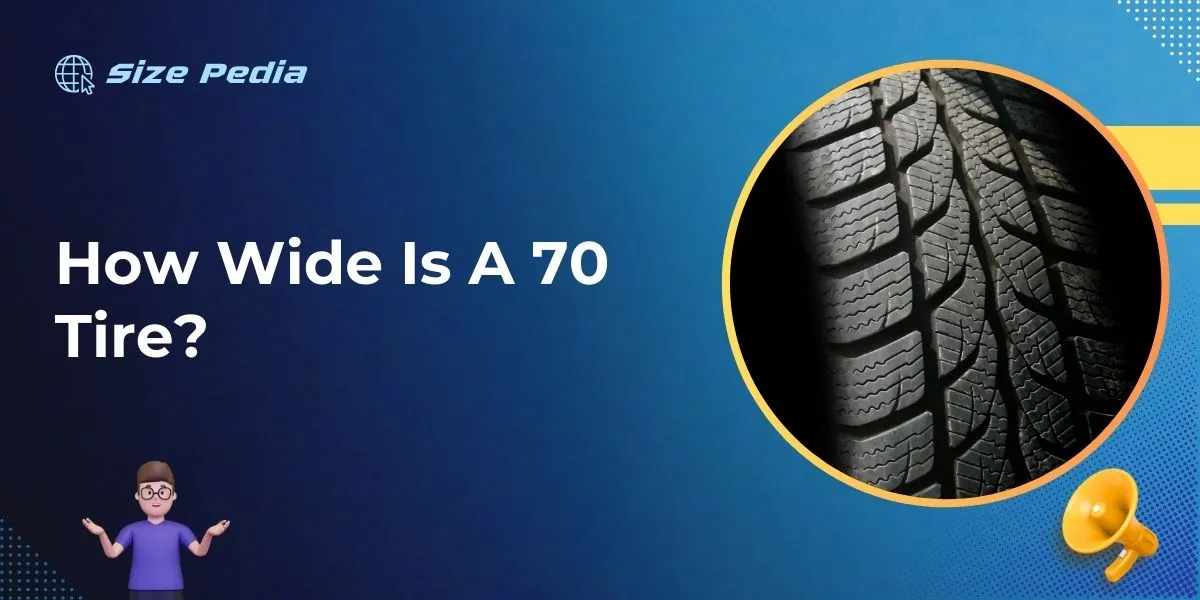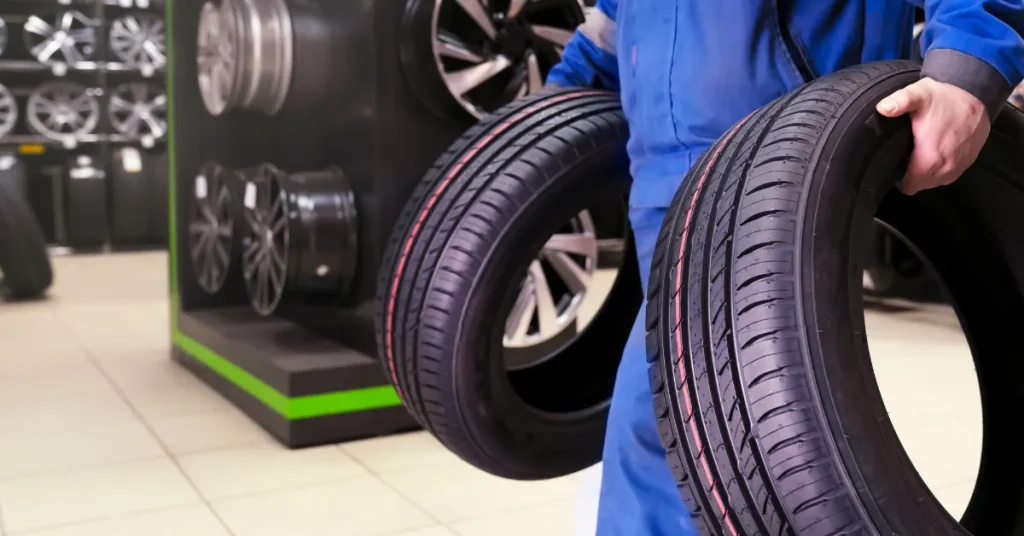A 70 tire has a sidewall height that is 70% of its width. This aspect ratio indicates a slightly taller sidewall compared to narrower tires.
Deciphering tire size is crucial for vehicle owners aiming to ensure proper fit and performance. The “70” in a tire size denotes the aspect ratio, which is the height of the tire’s sidewall relative to its width expressed as a percentage.
When shopping for tires, understanding this measurement can guide you in selecting a tire with the preferred balance of handling, comfort, and appearance.
It’s important to match the tire’s size to your specific vehicle requirements to maintain safety and optimize driving experience. By knowing the sidewall height, you’ll be one step closer to finding the best tire for your vehicle.

Decoding Tire Width Measurements
Understanding the width of a 70-series tire is crucial for safety and performance. Tire width is the first step in selecting the right tires for your vehicle. It impacts how your car accelerates, brakes, and handles on the road. Let’s break down what those numbers on the tire really mean.
70-series Tires: A Profile Introduction
The ’70’ in a 70-series tire refers to the aspect ratio. It is a percentage. This number tells you the height of the tire’s sidewall compared to its width. A 70-series tire has a sidewall height that is 70% of its width.
A lower number means a shorter sidewall. A higher number means a taller sidewall. The sidewall height affects the ride comfort and handling of the vehicle.
Tire Nomenclature: Reading The Numbers
Tire sizes are a combination of numbers and letters. They may look confusing, but each part has a meaning. For instance, in ‘P225/70R16’, ‘P’ stands for Passenger. ‘225’ is the tire width in millimeters.
- ‘R’ indicates the tire has a Radial construction.
- ’16’ is the diameter of the wheel in inches.
These widths are key to fitting the right tire on your wheel. They ensure your vehicle performs optimally.
| Tire Code Part | Meaning |
| P | Passenger Type Vehicle |
| 225 | Width of the Tire in Millimeters |
| 70 | Aspect Ratio (Sidewall Height to Width %) |
| R | Radial Construction of the Tire |
| 16 | Wheel Diameter in Inches |
Always check your vehicle’s manual before buying new tires. Different cars require different sizing. An incorrect tire size can cause problems.
The Anatomy Of A 70 Tire
Understanding the ‘The Anatomy of a 70 Tire’ is crucial for both automotive enthusiasts and everyday car owners. Tires marked with a “70” relate to the aspect ratio.
This number tells us the height of the tire sidewall as a percentage of the tire’s width. Now, let’s delve into the details of what these numbers mean and how they affect your ride.
Aspect Ratio Explained
The aspect ratio of a tire is a key feature. For a 70-series tire, the aspect ratio sits at 70%. This means the tire’s height is 70% of its width. A lower number means a lower sidewall, and vice versa. To visualize:
- Width: Total distance across the tread surface.
- Aspect Ratio: The sidewall’s height relative to the width.
- 70%: If a tire is 200mm wide, its sidewall is 140mm tall.
Impact Of Width On Vehicle Performance
The width of a tire, indicated before the “70”, influences several aspects of vehicle performance.
Wider tires typically offer better traction but can affect fuel efficiency. Consider these points:
- Handling: A wider footprint enhances grip on road surfaces.
- Fuel Economy: More width can mean more rolling resistance.
- Comfort: Width and aspect ratio together define ride smoothness.
Comparing 70 Tires With Other Profiles

When you dive into the world of tires, size really does matter. Profiles such as “70” refer to the height of the tire sidewall, a percentage of the tire’s width. This impacts how a car rides and looks. Let’s explore how 70 series tires stack up against other profiles.
70 Vs. 60 Series: Performance And Comfort Trade-offs
Tire profiles affect your vehicle’s handling and comfort. A 70 series tire has a taller sidewall than a 60 series. This extra height can absorb road bumps better, offering a smoother ride. But there’s a flip side.
- Performance: A 60 series provides better road feedback, enhancing handling.
- Comfort: The 70 series excels in cushioning your ride on rough surfaces.
Choosing between the two depends on your preference for comfort or sporty driving dynamics.
The Aesthetics Of Tire Width: Car Design Considerations
The width of a tire not only influences performance but also the look of your car. A 70 series tire often means a beefier, more classic appearance. This can complement vintage cars or off-road vehicles where a robust look is desirable.
Wider tires, like those found on lower profiles, tend to suggest a sportier edge. Car enthusiasts might opt for these to give their ride a sleek, aggressive stance. Yet, this decision should consider:
- Wheel well clearance
- Matching the tire width to appropriate rim size
- Overall vehicle aesthetics and design
The right tire width not only has a functional purpose but also serves to enhance your vehicle’s character.
Measurement Tools And Techniques
Understanding the width of a 70 tire requires precise tools. The right equipment ensures accuracy. The width of a tire impacts its performance. Drivers seek the correct tire dimensions. Proper measurements ensure safety and efficiency.
Calipers And Pressure Gauges: Precision In Numbers
Calipers provide tire width measurements. These tools offer exact numbers. To use a caliper:
- Place the caliper jaws across the widest tire section.
- Ensure the tool is perpendicular to the tire.
- Read the measurement on the scale.
Pressure gauges check tire inflation. Correct pressure affects tire width. Use a pressure gauge by:
- Removing the tire valve cap.
- Pressing the gauge onto the valve stem.
- Reading the pressure on the gauge display.
Professional Tire Measurement Services
Experts provide precision measurement services. Tire shops have trained technicians. They use advanced tools. These include:
- Digital measuring devices
- Calibration equipment
- Laser scanners
Tire professionals document each measurement. This ensures repeatable accuracy. Cars, trucks, or motorcycles receive tailored service. Trust professionals with tire measurement needs.
Selecting The Right Tire For Your Vehicle
Choosing the right tire for your vehicle is key for the best ride. Tires link your car to the road. For safety and performance, the fit must be perfect. Today, we dive into how a 70 tire width affects your driving experience.
Compatibility With Rim Width
Your rim width must match your tire width for best performance. Tires marked with ’70’ relate to the aspect ratio, not the width itself. The width is usually the first number in a tire size, like in ‘225/70R16’ where ‘225’ means the width in millimeters.
- Check the rim width range that fits your tire size.
- A rim too narrow or wide causes tire stress and leads to issues.
- Use the tire specification sheet or manufacturer recommendations to find the right size.
The Role Of Tire Width In Safety And Fuel Economy
The width of your tires influences grip and mileage. Wider tires can offer more grip but may also affect fuel economy.
| Tire Width | Grip Level | Fuel Efficiency |
| Narrower | Less Grip | More Efficient |
| Wider | More Grip | Less Efficient |
- Select tires to balance safety and economy.
- Consider weather conditions and driving habits when choosing width.
- Stick to manufacturer recommendations for the best balance.
Legal And Standardization Aspects Of Tire Width

Choosing the right tire width is crucial for safe driving. Legal standards ensure tires fit vehicles properly. The width of a 70 tire must meet these standards. Let’s explore two key regulatory bodies in tire width standardization.
Measurements and standardization make tire buying easier. Specific labels like ’70’ in tire sizes have legal backgrounds. Safety and performance depend on these standards.
Dot Regulations: Ensuring Safety On The Roads
The Department of Transportation (DOT) oversees tire safety in the United States. DOT sets tire standards, including width specifications. They require all tires to be safe for road use. Their rules help prevent accidents.
- Tire width is among these regulations.
- It affects the tire’s contact with the road.
- Proper width ensures stable handling.
Iso And Etrto: Global Tire Standards
The International Organization for Standardization (ISO) and the European Tyre and Rim Technical Organisation (ETRTO) aim for consistency in tire production.
- ISO defines tire width globally.
- ETRTO focuses on European standards.
- Both ensure tires match their labeled sizes.
Together, they make tire width easy to understand and cross-check between different countries and manufacturers.
FAQs About How Wide Is A 70 Tire
What Is 70 In Tire Width?
The number 70 in tire width indicates the aspect ratio, not the width; it’s the height of the tire’s sidewall expressed as a percentage of the tire’s width.
How Wide Is 285 70r17?
The width of a 285/70R17 tire is approximately 11. 22 inches or 285 millimeters.
How Wide Is A 75 Tire?
A 75 tire refers to its aspect ratio, not width; it means the tire’s height is 75% of its width. To find the exact width, you need the full tire code.
How Wide Is A 70 100 19 Tire?
A 70/100-19 tire is 70mm wide, suitable for motocross and off-road bikes. It offers a balance of grip and performance on various terrains.
Conclusion
Understanding the width of a 70 tire is crucial for vehicle compatibility and performance. With this guide, you’ve gained the knowledge to make informed decisions about your tire selection.
Always remember, proper tire width ensures a safer, smoother ride. Choose wisely for your driving needs and enjoy the journey ahead.
Resources:
1. https://www.fmcsa.dot.gov/safety/commercial-tire-safety-tips
